
Cultural Fusion: Embracing Diversity in European Lifestyles by 2025
Cultural Fusion: Embracing Diversity in European Lifestyles by 2025 is an exciting topic that has been gaining attention in recent years. As the world becomes increasingly interconnected, the need to understand and appreciate different cultures has never been more important.
Introduction to Cultural Fusion
Cultural fusion refers to the blending of different cultural practices, traditions, and values to create a new and unique cultural identity. This phenomenon is not new, but it has become more pronounced in recent years due to globalization, migration, and technological advancements.
In Europe, cultural fusion is particularly significant, as the continent is home to a diverse range of cultures, languages, and traditions. From the vibrant streets of Barcelona to the historic cities of Rome and Paris, Europe is a melting pot of cultures, each with its own unique character and charm.
Benefits of Cultural Fusion
The benefits of cultural fusion are numerous. It promotes diversity, inclusion, and understanding, which are essential for building a harmonious and cohesive society. Cultural fusion also encourages creativity, innovation, and progress, as different cultures bring new ideas and perspectives to the table.
In addition, cultural fusion helps to break down cultural and social barriers, promoting a sense of community and belonging among people from different backgrounds. It also provides an opportunity for people to learn about and appreciate different cultures, traditions, and customs, which can be both enriching and rewarding.
Examples of Cultural Fusion in Europe
There are many examples of cultural fusion in Europe, from the delicious fusion cuisine of London’s Brick Lane to the vibrant cultural festivals of Berlin. In Amsterdam, the city’s famous Jordaan neighborhood is home to a diverse range of cultures, from traditional Dutch to modern hipster, while in Madrid, the city’s Malasaña neighborhood is a hotspot for cultural fusion, with its street art, indie music, and eclectic mix of bars and restaurants.
In terms of food, cultural fusion is also evident in the rise of fusion cuisine, which combines different culinary traditions to create new and exciting flavors. From Korean tacos to sushi burgers, fusion food is a delicious reflection of the cultural diversity that exists in Europe today.
Challenges and Opportunities
While cultural fusion is a positive and enriching phenomenon, it also presents several challenges and opportunities. One of the main challenges is balancing the need to preserve traditional cultural identities with the need to embrace change and diversity.
Another challenge is addressing the potential risks of cultural appropriation, where elements of one culture are adopted by another without proper understanding, respect, or compensation. This can lead to cultural insensitivity and exploitation, which can be damaging to both the originating culture and the adopting culture.
However, with careful consideration and respect, cultural fusion can also provide opportunities for growth, innovation, and progress. By embracing diversity and promoting inclusivity, we can create a more vibrant, dynamic, and prosperous society, where different cultures can thrive and coexist in harmony.
Conclusion
In conclusion, cultural fusion is a powerful and transformative force that is shaping European lifestyles by 2025. By embracing diversity and promoting inclusivity, we can create a more vibrant, dynamic, and prosperous society, where different cultures can thrive and coexist in harmony.
As we look to the future, it is essential that we continue to celebrate and promote cultural fusion, while also addressing the challenges and opportunities that it presents. By doing so, we can build a brighter, more inclusive, and more enriching future for all, where cultural diversity is valued and respected.





